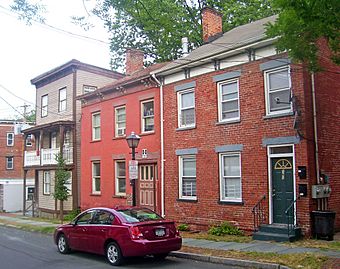Union Street Historic District (Poughkeepsie, New York) facts for kids
Quick facts for kids |
|
|
Union Street Historic District
|
|

Typical houses on Union Street, 2008
|
|

Map of Union Street Historic District
|
|
| Location | Poughkeepsie, NY |
|---|---|
| Area | 42 acres (17 ha) |
| Built | from 1767 |
| Architectural style | Federal, Late Victorian |
| NRHP reference No. | 71000537 |
| Added to NRHP | 1971 |
The Union Street Historic District in Poughkeepsie, New York, is a special area. It covers about eight city blocks, which is around 42 acres. This district is located southwest of downtown Poughkeepsie. It is also just north of the Mid-Hudson Bridge, which crosses the Hudson River.
This neighborhood is the oldest in Poughkeepsie. Its history goes back to 1767. That's when a path leading to the Hudson River was turned into a proper street. In 1971, the Union Street area was named a historic district. This means it's a place with important old buildings and history. It was the very first spot in Poughkeepsie to be added to the National Register of Historic Places.
Contents
Exploring the Union Street Area
The Union Street Historic District has a shape that is mostly like a rectangle. It has clear boundaries that help define it. To the north, it ends at the backyards of houses on the south side of Main Street. On the east, it follows the top of a hill that slopes down to the Hudson River. This is roughly behind the houses on the west side of Market Street.
To the south, the district is bordered by two main roads: US 44 and NY 55. These roads are part of the East-West Arterial. On the west, it meets US 9, which is the North-South Arterial. This entire area, covering 42 acres, had 173 important buildings when it was listed. None of these buildings are listed separately.
Streets and Scenery
Union Street itself runs through the district. It goes generally from the west-southwest to the east-northeast. Other streets fully included are Delano Street and Grand Street. Parts of South Bridge, South Clover, and South Perry streets are also within the district.
The land in the district slopes down towards the river. This means it's higher on the east side and lower on the west. All the streets here have buildings on them. There are only a few empty lots. The buildings and their lots are the smallest in Poughkeepsie. They are packed closely together. Many houses have backyards instead of side yards. The neighborhood also has many old, tall trees. These trees provide lots of shade and make the area look green and nice.
The Story of Union Street
Union Street started as a winding path. This path connected the first settlement of Poughkeepsie to a store on the river called the Union Store. The early settlement was around where Market Street is today. In 1767, this path was made wider and became the first road from Poughkeepsie to the river. Old maps from 1799 show it was called Union Store Road.
A Home for Many Cultures
Over time, a neighborhood grew around Union Street. It became the first home for many different groups of people who moved to Poughkeepsie. These included Germans, Irish, Poles, Italians, and other groups from Slavic countries. Many families stayed in the neighborhood for a long time. In the middle of the 1900s, the area became racially integrated. This happened when African-American families began to live there too.
How the Houses Changed Over Time
Throughout the 1800s, builders mostly used the same basic house design. They built two-and-a-half-story houses with three windows or doors on the front. They just changed the style a little to fit new architectural styles. At first, houses were made of brick with stone details. Then, they used wood. Later, they used more detailed brickwork.
The entrances to the houses also changed. They started with simple steps right to the street. Then, they had stoops, which are small staircases leading to the front door. By the end of the century, some houses had fancy verandas, which are like covered porches. Some buildings, usually at corners, had shops on the ground floor.
Community Life and Preservation
The houses were built on narrow lots. They had no space on the sides, only a backyard. This design helped create a strong sense of community among neighbors. It also clearly separated public spaces (the street) from private spaces (the homes). The unique angles of the streets and the sloping land gave each house its own special view of the neighborhood.
By the late 1960s, many areas around Union Street were torn down. This happened for new roads or big city improvement projects. But the Union Street area was given a special historic status. This made it much harder to tear down buildings there. This protected the neighborhood. It helped keep it looking much like it always had.

